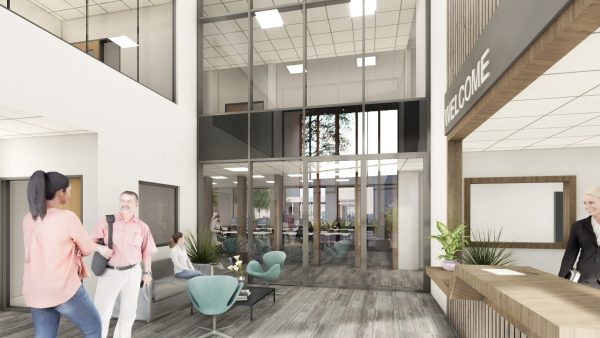
King Edward VI Handsworth Wood Girls’ Academy
Building Excellence in Education and Community – King Edward VI Handsworth Wood Girls’ Academy Redevelopment
The redevelopment of King Edward VI Handsworth Wood Girls’ Academy embodies a holistic approach to modern education, sustainability, and community integration.
Situated in a vibrant residential area of Birmingham, the project aimed to create a state-of-the-art educational facility while preserving its historic charm and environmental integrity.


Value
At the heart of the redevelopment was the goal to unlock a modern educational experience for 1,100 students aged 11–16 and 200 Sixth Formers. By creating a flexible and efficient layout, we ensured an inclusive, inspiring, and practical environment tailored to the Academy’s educational vision. The innovative use of a central courtyard not only maximises natural light but also creates a connectivity between the teaching spaces, dining hall, and sports facilities.
The strategic clustering of community-accessible areas like the sports hall, drama studio, and performance hall extends the building’s utility well beyond school hours, encouraging interaction among students, staff, and local residents. Crucially, our design mitigated significant site constraints, including protected tree zones and operational challenges during construction, by employing resourceful phasing plans. These ensured the Academy remained fully functional throughout. The preserved trees and new landscaping enrich the experience for pupils and visitors alike, blending learning with nature.


Impact
The redevelopment’s impact reverberates through educational, social, and economic spheres. Directly, it provided an exceptional environment for students to thrive academically, with specialised teaching spaces such as science laboratories and flexible social science classrooms. Indirectly, the community benefits from enhanced access to quality recreational and cultural facilities. It creates safe, adaptable spaces for local events, from sports tournaments to art exhibitions, strengthening ties with residents.
Economically, the Academy’s zero-carbon operational design sets a benchmark for future developments, reducing energy costs and inspiring other institutions to adopt sustainable practices. Environmental impacts were minimised through sensitive design and construction methods. Mature trees were retained, contributing to local biodiversity, while green roofs and meadow grass areas amplified ecological connectivity.

The academy’s transformation balances quality design with community values, delivering a zero-carbon campus that empowers students, engages the local community, and preserves the site’s natural heritage.
Sustainability
Achieving a zero-carbon operational target was no small feat, but it came to life through clever design and cutting-edge technology. The building’s story begins with passive design strategies and advanced insulation, woven seamlessly with renewable energy technologies such as bio-solar and photovoltaic roofs. Together, these elements ensure the Academy not only meets today’s environmental benchmarks but is also ready to tackle the challenges of tomorrow. Inside, the layout tells its own tale of efficiency and foresight. Every space, from optimised room sizes to adaptable teaching clusters, was designed to support evolving curriculum needs. Structural grids and window arrangements were standardised with an eye on the future, allowing for easy expansion while minimising waste.
The construction phase followed a similarly thoughtful path. Careful planning ensured the work was phased to save time and keep disruptions to a minimum. By retaining existing infrastructure, such as the Sixth Form Centre, the project reduced material consumption. Meanwhile, innovative landscaping strategies gave new life to on-site resources, boosting biodiversity and adding a green flourish to the Academy’s surroundings.


Details
Information
Scope Architectural Design RIBA 0 to 7 Status Ongoing Location Birmingham Value £21m